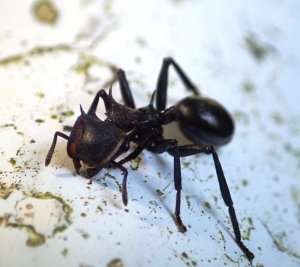New research studies adhesiveness in ants as a way to improve synthetic adhesives

Many of us are used to encountering ants scampering across a sidewalk, a trail path or even in our kitchen floor. But in many parts of the world, like the tropical regions of Central America, ants live their lives up in trees and utilize adhesive pads and claws to scurry from their colonies to tree limbs, branches and leaves in search of food. While foraging for food, wingless worker ants encounter significant environmental challenges like rain and wind. Villanova University biology assistant professor, Alyssa Stark, Ph.D., set out to find how ants adhere to surfaces under different conditions.
Stark and her research colleague, Stephen Yanoviak, Ph.D., from the University of Louisville, studied adhesive performance of one species of tropical canopy ant in Panama when sticking to glass, plastic and wood substrates under dry and wet conditions, replicating the highly variable conditions of the tropical canopy.
To measure the effectiveness of the adhesive pads, Stark tied a string to the ants and determined the amount of force required to either pull an ant off, or slide an ant along each substrate. The research team also looked at how running speed was impacted under wet conditions.
Their results showed that it took the same force to be pulled straight off a wet hydrophobic substrate as a dry hydrophobic substrate. However, when ants were slid, a wet surface negatively impacted the use of the ant's adhesive pads on all substrates. When measuring speed, water again impacted the adhesiveness and therefore the rate at which the ant could move on all substrates. In the field, the researchers noticed that ants were not active during periods of rainfall, which aligned with their findings in the lab. The results of this study suggest that reduction in adhesion and sprint speed on rain-wetted surfaces limits the activity of at least one tropical canopy ant species.
So what does this all mean?
"This is just the beginning of a much bigger question about how and where ants forage in the canopy, and ultimately, how their tiny adhesive feet can help inspire us to develop more versatile reusable adhesives," said Stark. "Our next step is to test the adhesive performance of other species in the canopy, and explore adhesion and running speed on hot, wet and rough substrates. We hypothesize that some ants are better at adhering in these extreme conditions than others, and that variation in adhesion drives ant distribution in the canopy. Exploration of the structure and function of canopy ant adhesive systems will help us improve our understanding of their ecology and the evolution of this impressive adhesive system. Using this knowledge, we hope to create ant-inspired synthetic adhesives for widespread use in the future."
Stark's area of research is centered around environmental factors that impact the functional morphology of organisms, focusing primarily on how organisms stick to surfaces in dynamic environments. Currently she works with ants, geckos and sea urchins. More of her work can be found here.
Provided by Villanova University



















